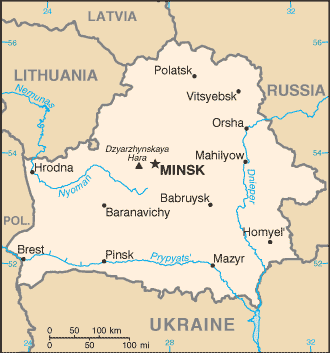Belarus
Belarus is a landlocked nation of Eastern Europe with the capital Minsk. Belarus borders Poland on the west, Lithuania on the northwest, Latvia on the north, Russia on the east, and Ukraine on the south. The country is formally named the Republic of Belarus. The present Slavic population of Belarus settled there between the 6th and the 8th century. The Early East Slavs gradually came in contact with the Varangians and were organized under the Rus', notably in the principality of Polatsk in modern-day northern Belarus. By the 13th century, the state of Rus was gravely impacted by the Mongol invasion. Belarusian territories were the core of newly created Grand Duchy of Lithuania. The city of Navahradak in today's western Belarus was the first capital of this state. This duchy as well included a number of territories of Rus' and Samogitia. There was no discrimination against any of nations or religions nor any major tension between them and people of them all dominated in their own regions. The Grand Duchy stretched across much of Eastern Europe from the Baltic Sea to the Black Sea in 15th century. Since February 2, 1386, when Grand Duke Yahaila was crowned the King of Poland, Grand Duchy was joint with Poland in a personal union under one monarch. In 1569 Poland and Grand Duchy formally merged into the new state of Polish-Lithuanian Commonwealth. This union remained in force until the May Constitution of 1791, which abolished all the subdivisions of the states and merged into Kingdom of Poland. However, the new state was annexed soon afterwards by Imperial Russia, Prussia and Austria in the effect of the Partitions of Poland of 1795. After the Russian Revolution of 1917, at the end of the German occupation during World War I, on March 25, 1918 Belarusians declared their independence for the first time, but the Belarus National Republic (Беларуская Народная Рэспубліка) was short-lived and didn't manage to remain independent. In modern Belarus, Lukashenko's official historians disregard the date of the independence proclaimed by BNR, but many Belarusians celebrate March 25 every year both publicly and in private. In 1919, the Byelorussian SSR was declared, which in 1922 became one of the founding members of the Soviet Union. In World War II, Belarus was occupied by Nazi Germany between 1941 and 1944. Another notable harsh period in Belarusian history was the Chernobyl accident of 1986. Belarus declared independence from the Soviet Union on July 27, 1990. On December 8, 1991, the leaders of Russia (Boris Yeltsin), Ukraine (Leonid Kravchuk), and Belarus (Stanislav Shushkevich) republics met in Belarus, in Belavezhskaya Pushcha, to issue a declaration that the Soviet Union was dissolved and replaced by the Commonwealth of Independent States.
This article is licensed under the GNU Free Documentation License. It uses material from the Wikipedia article "Belarus". |
||||||||||

